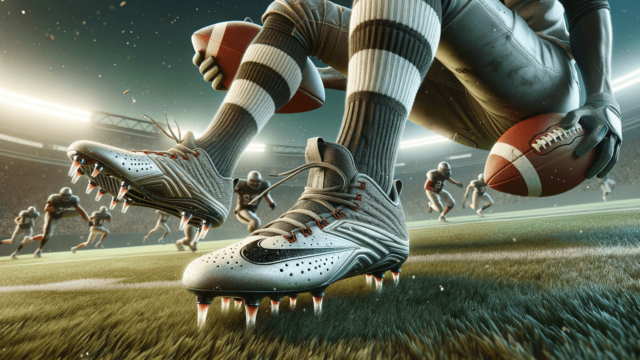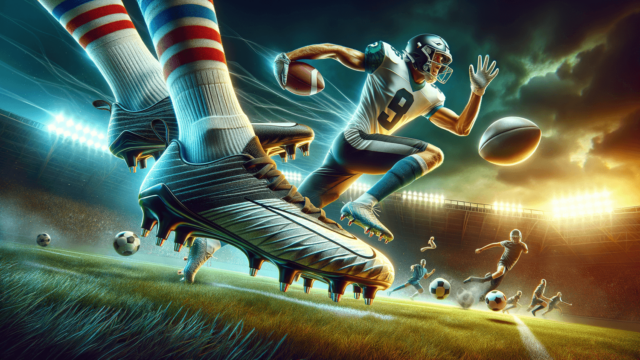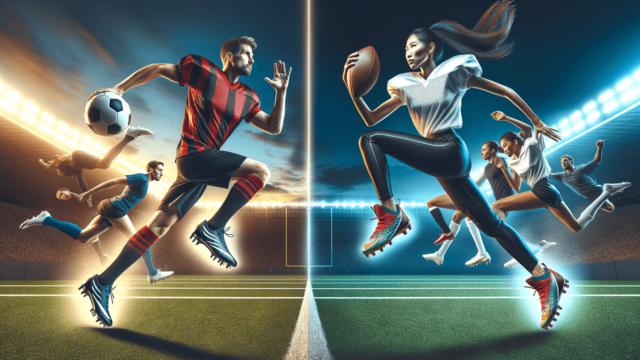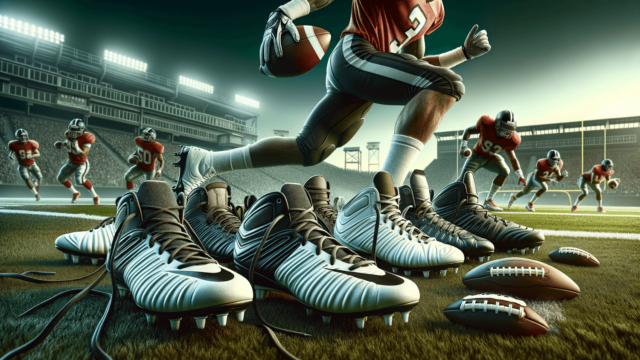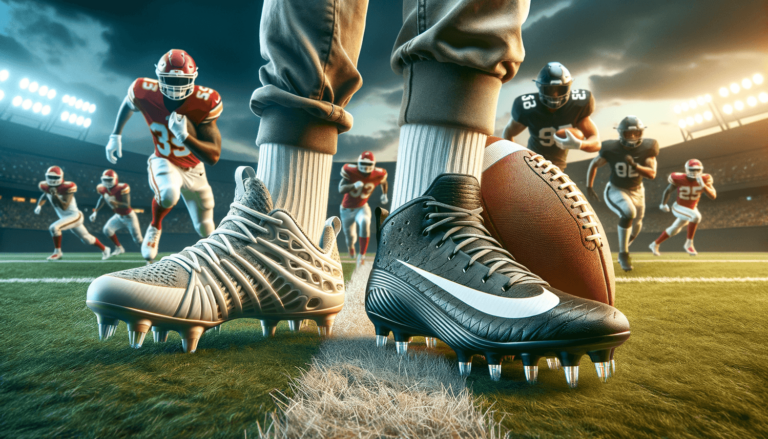
No, you cannot use baseball cleats for football, as they have different designs and functions to cater each sport’s specific needs. Football cleats have more support around the ankle, while baseball cleats prioritize flexibility and range of motion. Using the wrong cleats can hinder performance and increase injury risk.
Baseball Cleats vs Football Cleats
The main difference between baseball and football cleats lies in their structure, purpose, and how they’re designed to cater to each sport’s specific demands. Using the right cleats is essential for optimal performance and the prevention of injuries on the field.
Understanding the Design Differences
Football Cleats
Football cleats offer additional support around the ankle, as football players require more ankle stability due to the explosive movements and frequent direction changes that occur during the game. Most football cleats have a higher cut, which keeps the player’s ankle secure throughout the game.
Baseball Cleats
Baseball cleats, on the other hand, prioritize increased flexibility and a wider range of motion. These cleats are designed for quick and efficient sprints between bases and quick lateral movements. Baseball cleats are usually lower cut and lighter in weight to not restrict the player’s movement on the field.
Significance of Cleat Patterns
Football Cleat Patterns
Football cleats come in a variety of patterns specifically designed for different positions and field conditions. Players can opt for molded or detachable cleats, both of which offer traction and stability. Positions like linemen may need a heavier cleat with more ankle support, whereas skilled positions require lightweight cleats for increased speed.
Baseball Cleat Patterns
Baseball cleats consist predominantly of metal, molded plastic, or rubber spikes. Metal spikes provide excellent traction on dirt surfaces, which is essential for baseball players. Molded plastic and rubber spikes offer better traction on artificial turf but are generally less durable than metal ones.
Risks of Using Inappropriate Cleats
Using the incorrect cleat type not only hampers an athlete’s performance but also increases the risk of injuries. For example, football players who wear baseball cleats may experience discomfort and instability due to the cleats’ lower cut design, lack of ankle support, and improper spike patterns. This may result in ankle sprains, lack of proper grip, and potentially more serious injuries.
Importance of Position-Specific Cleats
It is crucial to choose the right type of cleats based on the position one plays in football. Football cleats are designed to cater to each player’s unique requirements, such as support, traction, or agility. Linemen, for example, need cleats with extra ankle support and stability, while running backs and wide receivers will need lightweight cleats for swift lateral movements and acceleration.
Suitable Cleats for Artificial Turf
While natural grass remains popular, many sports facilities are now utilizing artificial turf for their fields. Turf is durable, low-maintenance, and provides a consistent playing surface. When playing on an artificial surface, selecting the correct footwear is crucial to ensure traction, stability, and injury prevention. When playing football on artificial turf, opt for turf-specific shoes or cleats with molded plastic or rubber studs. Avoid using metal baseball cleats, as they might harm the artificial surface and pose injury risks to players.
Adhering to Equipment Rules and Regulations
Many sports leagues have specific rules and regulations regarding equipment, including footwear. For instance, metal baseball cleats may not be allowed in football due to potential injury risks. To avoid penalties and ensure the safety of all players, check with your league’s rules before using a specific type of footwear to play.
Maintaining Proper Footwear Care
Footwear maintenance is essential for prolonging the life of your cleats. Regularly monitor the condition of your cleats to ensure continued performance and safety. Replace damaged or worn-out cleats to avoid potential injuries caused by inadequate footwear.
FAQ Section – Football vs Baseball Cleats
After understanding the differences between baseball and football cleats, you may still have a few questions. Here we’ve compiled a list of frequently asked questions related to this topic to provide you with quick and concise answers.
Can I use football cleats for playing baseball?
No, football cleats are not suitable for playing baseball, as their spike patterns and higher-cut design are tailored for the requirements of football players. Using football cleats in baseball may hinder your performance on the field and increase the risk of injuries.
Are soccer cleats an appropriate alternative for football cleats?
While soccer cleats may appear similar to football cleats, they are not ideal substitutes. Soccer cleats lack the necessary ankle support for football and do not have a toe spike, which is essential for football players to gain traction during the game. Using soccer cleats in football may negatively impact your performance and increase the risk of injury.
What are the key features to look for in football cleats?
When selecting football cleats, prioritize ankle support, proper fit, traction, and comfort. The specific design and cleat pattern you choose will depend on your position, playing style, and the type of field you play on. Additionally, consider materials and weight to ensure the cleats meet your performance requirements.
How often should I replace my cleats?
There’s no definitive timeline for replacing cleats, as it depends on factors such as frequency of use, field conditions, and the cleats’ quality. Regularly inspect your cleats for signs of wear and damage, and replace them when you notice a decline in performance, compromised safety, or discomfort during play.
Do football leagues typically have cleat restrictions?
Many football leagues have specific rules regarding footwear to ensure the safety of all players on the field. It’s essential to consult your league’s regulations before purchasing cleats, as requirements may vary between leagues and age groups.
Featured Posts
- No pillar pages found.
